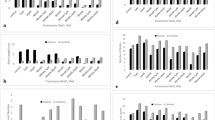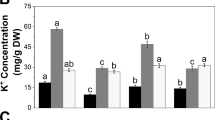Abstract
In an attempt to improve growth and secondary metabolite production, and to understand the possible mechanism involved in relation to the changes in physiology and activities of antioxidant enzymes, we cultured Morinda citrifolia adventitious roots in different strength (0.25, 0.50, 0.75, 1.0, 1.5 and 2.0) of Murashige and Skoog (MS) medium supplemented with 5 mg l−1 indole butyric acid and 30 g l−1 sucrose. Quarter-strength MS medium was proven suitable for the production of both root biomass and secondary metabolites [anthraquinone (AQ), phenolics and flavonoids]. With the increasing salt strength, root growth and AQ accumulation decreased significantly. Higher (1.5 and 2 MS) salt strength provoked osmotic stress resulted in more than twofold free proline accumulation than lower salt strength treated roots and induced free radical scavenging activity. Phenylalanine ammonia lyase activity showed a positive correlation in relation to salt strength that leads to an increase in phenol biosynthesis in expense of AQ formation. The elevated catalase (CAT), guaiacol peroxidase (G-POD) and superoxide dismutase activities and decreased ascorbate peroxidase (APX) activities were observed in roots treated with 2.0 MS. On the other hand, APX activity was strongly activated along with considerable increase in CAT activity at 0.25 MS treated culture. However, the joint functions of CAT, G-POD and APX at 0.25 MS treated cultures were efficient to eliminate the potential danger of hydrogen peroxide (H2O2) as evidenced from low H2O2 accumulation and low level of lipid peroxidation.






Similar content being viewed by others
Abbreviations
- AQ:
-
Anthraquinone
- APX:
-
Ascorbate peroxidase
- CAT:
-
Catalase
- DPPH:
-
1, 1-diphenyl-2-picrylhydrazyl
- EC:
-
Electrical conductivity
- G-POD:
-
Guaiacol peroxidase
- IBA:
-
Indole butyric acid
- MDA:
-
Malondialdehyde
- MS:
-
Murashige and Skoog
- PAL:
-
Phenylalanine ammonia lyase
- SOD:
-
Superoxide dismutase
- WP:
-
Water potential
References
Ahmad P, Sarwat M, Sharma S (2008) Reactive oxygen species, antioxidants and signaling in plants. J Plant Biol 51(3):167–173
Ahmed S, Hahn EJ, Paek KY (2008) Aeration volume and photosynthetic photon flux affect cell growth and secondary metabolite contents in bioreactor cultures of M. citrifolia. J Plant Biol 51(3):209–212
Ali MB, Singh N, Shohael AM, Hahn EJ, Paek KY (2006) Phenolics metabolism and lignin synthesis in root suspension cultures of Panax ginseng in response to copper stress. Plant Sci 171:147–154
Apel K, Hirt H (2004) Reactive oxygen species: metabolism, oxidative stress, and signal transduction. Annu Rev Plant Biol 55:373–399
Baque MA, Hahn EJ, Paek KY (2009) Growth, secondary metabolite production and antioxidant enzyme response of M. citrifolia adventitious root as affected by auxin and cytokinin. Plant Biotechnol Rep. doi:10.1007/s11816-009-0121-8
Baque MA, Hahn EJ, Paek KY (2010) Induction mechanism of adventitious root from leaf explants of M. citrifolia as affected by auxin and light quality. In Vitro Cell Dev Biol Plant 46:71–80
Bates LS, Waldren RP, Teare ID (1973) Rapid determination of free proline for water stress studies. Plant Soil 39:205–207
Benavides MP, Marconi PL, Gallego SM, Combo ME, Tomaro ML (2000) Relationship between antioxidant defence system and salt tolerance in Solanum tuberosum. Aust J Plant Physiol 27:273–278
Bisht SS, Sharma A, Chaturvedi K (1989) Certain metabolic lesions of chromium toxicity in radish. Indian J Agric Biochem 2:109–115
Boudet AM (2007) Evolution and current status of research in phenolic compounds. Phytochem 68:2722–2735
Bradford MM (1976) A rapid and sensitive method for the quantization of microgram quantities of protein utilizing the principle of protein-dye binding. Anal Biochem 72:248–254
Dewir YH, Hahn EJ, Paek KY (2005) Ornamental Euphorbia and Spathiphyllum: Application of bioreactor system and microponics for large-scale production, in vitro flowering and its physiology. Ph.D. thesis, Chungbuk National University, Cheongju, Korea
Diaz J, Merino F (1997) Shikimate dehydrogenase from pepper (Capsicum annuum) seedlings, purification and properties. Physiol Plant 100:147–152
Dickerson DP, Pascholati SF, Hagerman AE, Butler LG, Nicholson RL (1984) Phenylalanine ammonia-lyase and hydroxycinnamate: CoA ligase in maize mesocotyles inoculated with Helminthosporium maydis or Helminthosporium carbonum. Physiol Pl Path 25:111–123
Dornenburg H, Knorr D (1995) Strategies for the improvement of secondary metabolite production in plant cell cultures. Enzyme Microb Technol 17:674–684
Fecht-Christoffers MM, Maier P, Horst WJ (2003) Apoplastic per-oxidases and ascorbate are involved in manganese toxicity and tolerance of Vigna unguiculata. Physiol Plant 117:237–244
Ferrat L, Pergent-Martini C, Romeo M (2003) Assessment of the use of biomarkers in aquatic plants for the evaluation of environmental quality: application to seagrasses. Aquat Toxicol 65:187–204
Hare PD, Cress WA (1997) Metabolic implications of stress-induced proline accumulation in plants. Plant Growth Regul 21:79–102
Harinasut P, Poonsopa D, Roengmongkoi K, Charoensataporn R (2003) Salt effect on antioxidant enzymes in mulberry cultivar. Sci Asia 29:109–113
Hatano T, Kagawa H, Yasuhara T, Okuda T (1998) Two new flavonoids and other constituents in licorice: their relative astringency and radical scavenging effects. Chem Pharm Bull 36:2090–2097
Heath RL, Packer L (1968) Photoperoxidation in isolated chloroplasts I Kinetics and stoichiometry of fatty acid peroxidation. Arch Biochem Biophys 125:189–198
Kombrink E, Somssich IE (1995) Defense responses of plants to pathogens. Adv Bot Res 21:1–34
Liang YC (1999) Effects of silicon on enzyme activity and sodium, potassium and calcium concentration in barley under salt stress. Plant Soil 209:217–224
Lin CC, Kao CH (2000) Effect of NaCl on H2O2 metabolism in rice leaves. Plant Growth Regul 30:151–155
Lutts S, Kinet JM, Bouharmont J (1996) Effects of salt stress on growth, mineral nutrition and proline accumulation in relation to osmotic adjustment in rice cultivars differing in salt resistance. Plant Growth Regul 19:207–218
Nakano Y, Asada K (1981) Hydrogen peroxide is scavenged by ascorbate specific peroxidase in spinach chloroplast. Plant Cell Physiol 22:867–880
Nandwal AS, Godara M, Sheokand A, Kamboj DV, Kundu BS, Kuhad MS, Kumar B, Sharma SK (2000) Salinity induced changes in plant water status, nodule functioning and ionic distribution in phenotypically differing genotypes of Vigna raline L. J Plant Physiol 156:350–359
Neill SJ, Radhika D, Andrew C, Roger DH, John TH (2002) Hydrogen peroxide and nitric oxide as signaling molecules in plants. J Exp Bot 53:1237–1247
Nobuhiro S, Mittler R (2006) Reactive oxygen species and temperature stress: a delicate balance between signaling and destruction. Physiol Plant 126:45–51
Noctor G, Foyer CH (1998) Ascorbate and glutathione: keeping active oxygen under control. Annu Rev Plant Physiol Plant Mol Biol 49:249–279
Putter J (1974) Peroxidases. In: Bergmeyer HU (ed) Methods of enzymatic analysis. Academic Press, New York, pp 685–690
Ryu DDY, Lee SO, Romani RJ (1990) Determination of growth rate for plant cell culture: comparative studies. Biotechnol Bioeng 35:305–311
Sakihama Y, Yamasaki H (2002) Lipid peroxidation induced by phenolic in conjunction with aluminium ions. Biol Plant 45:249–252
Sergiev I, Alexieva V, Karanov E (1997) Effect of spermine, atrazine and combination between them on some endogenous protective systems and stress markers in plants. C R Acad Bulg Sci 51:121–124
Shalata A, Mittova V, Volokita M, Guy M, Tal M (2001) Response of cultivated tomato and its wild salt tolerant relative Lycopersicon pennellii to salt dependent oxidative stress: the antioxidative system. Physiol Plant 112:487–494
Shigeoka S, Ishikawa T, Tamoi M, Miyagawa Y, Takeda T, Yabuta Y (2002) Regulation and function of ascorbate peroxidase isoenzymes. J Exp Bot 53:1305–1319
Silveira JAG, Melo ARB, Viegas RA, Oliveira JTA (2001) Salinity induced effects on nitrogen assimilation related to growth in cowpea plants. Environ Exp Bot 46:171–179
Sivakumar G, Yu KW, Paek KY (2005) Production of biomass and ginsenoside from adventitious roots of Panax ginseng in bioreactor cultures. Eng Life Sci 5:333–342
Sudhakar C, Lakshmi A, Giridarakumar S (2001) Changes in the antioxidant enzyme efficacy in two high yielding genotypes of mulberry (Morus alba L) under NaCl salinity. Plant Sci 16:613–619
Wang MY, Brett JW, Jensen CJ, Nowicki D, Su C, Paul AK, Anderson G (2002) M. citrifolia (Noni): a literature review and recent advances in noni research. Acta Pharmacol Sin 23(12):1127–1141
Wu CH, Dewir YH, Hahn EJ, Paek KY (2006) Optimization of culturing conditions for the production of biomass and phenolics from adventitious roots of Echinacea angustifolia. J Plant Biol 49:193–199
Yamamoto O, Kamura K (1997) Production of saikosaponin in cultured roots of Bupleurum falcatum L. Plant Tiss Cult Biotechnol 3:138–147
Yu KW, Hahn EJ, Paek KY (2000) Production of adventitious ginseng roots using bioreactors. Kor J Plant Tiss Cult 27:309–315
Zenk MH, Shagi HEL, Schulte U (1975) Anthraquinone production by cell suspension cultures of M. citrifolia. Planta Med 28:79–101
Acknowledgments
This research work is partially supported by basic science program through the National Research Foundation of Korea (NRF) funded by the Ministry of Education, Science and Technology, Republic of Korea. The author expresses his sincere thanks to Dr. Elena V. Popova (National Agrobiodiversity Center, RDA, Republic of Korea) to edit the article and constructive suggestions.
Author information
Authors and Affiliations
Corresponding author
Additional information
Communicated by J. Zou.
Rights and permissions
About this article
Cite this article
Abdullahil Baque, M., Lee, EJ. & Paek, KY. Medium salt strength induced changes in growth, physiology and secondary metabolite content in adventitious roots of Morinda citrifolia: the role of antioxidant enzymes and phenylalanine ammonia lyase. Plant Cell Rep 29, 685–694 (2010). https://doi.org/10.1007/s00299-010-0854-4
Received:
Revised:
Accepted:
Published:
Issue Date:
DOI: https://doi.org/10.1007/s00299-010-0854-4




